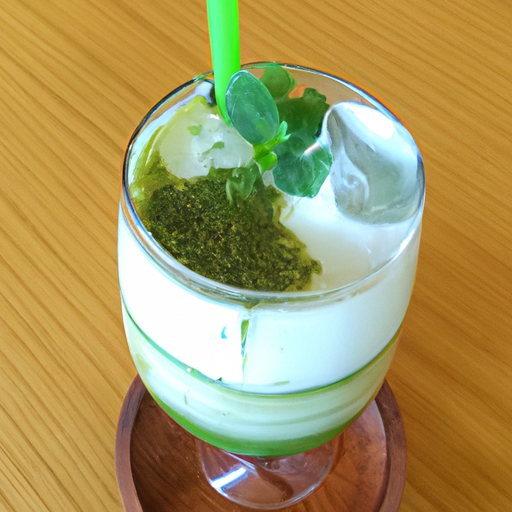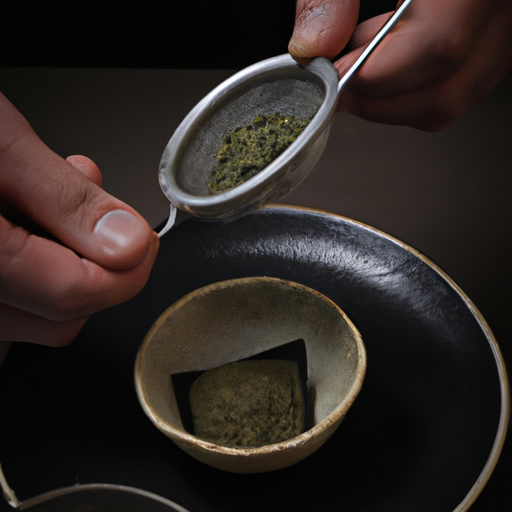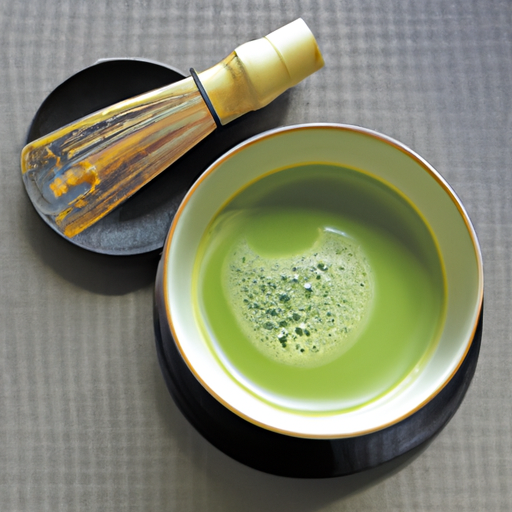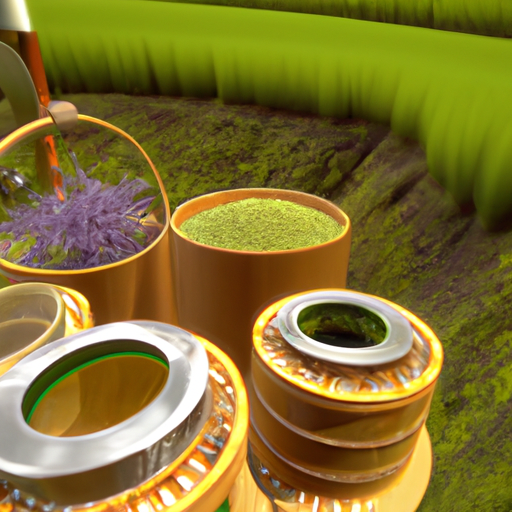Each time I enjoy a gulp of my iced matcha latte, I experience the revitalizing and invigorating effects spreading throughout my body. The drink’s lively green hue delights the visual senses, while its gentle earthy taste, complemented by a slight sweetness, pleasures the palate.
But what exactly is an iced matcha latte?
Well, my dear reader, let me enlighten you. Matcha is a type of powdered green tea that has been used in traditional Japanese tea ceremonies for centuries. It is made by grinding green tea leaves into a fine powder and then whisking it with hot water.
In recent years, matcha has gained popularity in the Western world, particularly in the form of matcha lattes. And an iced matcha latte? It’s a delicious and refreshing twist on this classic beverage that is perfect for hot summer days or anytime you need a pick-me-up.
So, let’s dive into the world of iced matcha lattes and discover what makes them so special.
Key Takeaways
- An iced matcha latte is a refreshing and healthier alternative to traditional coffee drinks.
- Matcha is high in antioxidants, vitamins, and nutrients, making it a potent source of health benefits.
- Sustainable and ethical production practices are crucial for preserving the cultural heritage and historical significance of matcha.
- Supporting companies that prioritize sustainability practices can help contribute to a more sustainable future while enjoying the delicious taste of iced matcha latte.
What Is Matcha?
So, you’re probably wondering what matcha actually is – it’s a finely ground powder made from specially grown green tea leaves that’s packed with antioxidants and a unique earthy flavor. Matcha has been cultivated in Japan for centuries and is an integral part of traditional Japanese tea ceremonies.
The cultivation process involves shading the tea plants for several weeks before harvesting, which increases the chlorophyll content and gives the leaves their vibrant green color. When it comes to preparing matcha, the traditional method involves whisking the powder with hot water until it becomes frothy. This creates a bright green tea with a smooth, creamy texture and a slightly bitter taste.
Matcha is also used in a variety of culinary applications, from baked goods to smoothies, and is prized for its vibrant color and health benefits. The rise of matcha lattes has brought this traditional Japanese beverage into the mainstream. By combining matcha with steamed milk and a touch of sweetness, the bitterness of the tea is balanced out and the unique flavor profile is highlighted.
So, now that you know what matcha is, let’s delve into the world of iced matcha lattes.
The Rise of Matcha Lattes
I’ve noticed a surge in popularity of matcha lattes in the West over the past few years.
Not only are they a delicious and refreshing drink, but they also align with the growing health and wellness trends.
It’s becoming more and more common to find matcha lattes on the menus of coffee shops and cafes, making them accessible to anyone looking for a tasty and healthy beverage option.
Popularity in the West
The iced matcha latte has taken the West by storm, becoming a favorite among trendy coffee shops and health-conscious consumers alike. Its popularity factors stem from its unique flavor profile, which is both sweet and earthy, and its vibrant green color.
While matcha lattes have been a staple in Japan for centuries, the cultural differences in the West have allowed it to become a popular symbol of health and wellness. Many coffee shops offer iced matcha lattes as a healthier alternative to traditional coffee drinks. Matcha is high in antioxidants and contains caffeine, which provides a natural energy boost without the jitters of coffee.
Additionally, the drink is often made with alternative milks, such as almond or oat milk, making it a great option for those with dietary restrictions. The popularity of the iced matcha latte speaks to the increasing interest in health and wellness trends, as consumers look for ways to incorporate nutrient-dense and natural ingredients into their diets.
Health and Wellness Trends
With the rise of health and wellness trends, people are seeking out natural and nutrient-dense ingredients to incorporate into their diets. Matcha, a powdered green tea, has become a popular choice due to its numerous health benefits.
Not only is it high in antioxidants and vitamins, but it also contains caffeine and L-theanine, which can provide a gentle energy boost and improve mental clarity. As more people prioritize their mental health and fitness routines, they are turning to iced matcha lattes as a refreshing and nourishing drink option.
Additionally, matcha is known for its ability to boost metabolism and aid in weight loss, making it a popular choice for those looking to maintain a healthy lifestyle. Incorporating matcha into your daily routine can be as simple as swapping out your morning coffee or incorporating it into your smoothies or baked goods. Availability at coffee shops is becoming more widespread, making it easier for individuals to enjoy this delicious and nutritious beverage on-the-go.
Availability at Coffee Shops
As matcha availability increases at coffee shops, customers can easily enjoy the health benefits of this nutritious ingredient in their favorite beverages. Coffee shop trends are showing that consumers are looking for healthier alternatives to traditional coffee drinks. Matcha, a finely ground green tea powder, offers a unique taste and a variety of health benefits, including high levels of antioxidants and metabolism-boosting properties.
To accommodate consumer preferences, coffee shops are now offering matcha lattes and iced matcha lattes as a healthier alternative to traditional coffee drinks. Here is a table of some popular coffee shops that offer iced matcha lattes:
| Coffee Shop | Iced Matcha Latte Price | Availability |
|---|---|---|
| Starbucks | $4.45 | Nationwide |
| Dunkin’ | $3.99 | Select areas |
| Peet’s | $4.25 | Nationwide |
| Caribou | $4.29 | Select areas |
With the increasing availability of matcha at coffee shops, it’s now easier than ever to make an iced matcha latte at home.
Making an Iced Matcha Latte
To make an iced matcha latte, you’ll need to scoop a generous amount of matcha powder into a cup. Matcha powder is a finely ground green tea powder that has a slightly sweet and earthy taste. It’s important to use high-quality matcha powder to get the best flavor and health benefits out of your latte.
Next, add a splash of hot water to the matcha powder and whisk it until it’s smooth and free of lumps. This will create a concentrated matcha paste that will form the base of your latte.
Once you have the paste, add your choice of milk and sweetener to the cup and stir everything together until it’s well combined.
There are many variations of iced matcha latte recipes out there, so feel free to experiment and find the one that suits your taste buds the best. Some popular additions to the basic recipe include vanilla syrup, coconut milk, or even a shot of espresso for an extra kick of caffeine.
Now that you know how to make a delicious iced matcha latte, let’s move on to the health benefits this drink can offer.
Health Benefits of an Iced Matcha Latte
I absolutely love an iced matcha latte, not just because it’s delicious, but also because it offers incredible health benefits.
Matcha is loaded with antioxidants, which help to fight off harmful free radicals in the body. Additionally, it’s incredibly nutrient-dense, offering a wide range of vitamins and minerals that are essential for overall health and wellness.
Finally, the caffeine in matcha provides a natural energy boost that can help you power through your day and stay focused and alert.
Antioxidants
Antioxidants are like the superhero that saves your cells from damaging free radicals, much like how Batman swoops in to save Gotham City from villains. They’re molecules that can prevent or slow down oxidative damage to our cells caused by these unstable molecules.
Matcha, being a superfood, is rich in antioxidants, specifically catechins, which are a type of flavonoid. These catechins are what make matcha a potent tool in fighting off harmful free radicals that can cause cell damage, aging, and even diseases such as cancer. The brewing techniques used to make matcha also contribute to its high antioxidant content.
Unlike other tea types, matcha is made from a fine powder that is fully consumed, making it a more concentrated source of antioxidants. Moreover, shade-grown matcha is especially rich in chlorophyll, which is responsible for its bright green color and is believed to have additional health benefits. These factors make an iced matcha latte not only a refreshing drink but also a potent source of antioxidants that can help protect your cells and promote overall well-being.
Moving on to the next section, let’s explore the nutrient density of an iced matcha latte.
Nutrient Density
You’ll be happy to know that this drink isn’t just delicious, but also packed with nutrients that your body will thank you for.
The matcha powder used in an iced matcha latte is made from ground green tea leaves, which are rich in antioxidants, vitamins, and minerals. But what really sets matcha apart from other types of tea is its high nutrient density.
Nutrient density refers to the amount of nutrients in a food or drink relative to its calorie content. Matcha is known for its exceptional nutrient density because it contains a concentrated amount of vitamins and minerals compared to other green teas.
Additionally, the nutrients in matcha are easily absorbed by the body due to the way it’s prepared. When you drink an iced matcha latte, you can be confident that your body is getting the most out of every sip thanks to its high nutrient absorption and bioavailability.
With all these benefits, it’s no wonder that an iced matcha latte is a popular choice for a quick energy boost.
Energy Boost
Need a quick pick-me-up? Try this energizing drink made with a special ingredient known for its ability to boost focus and alertness. An iced matcha latte is a perfect drink for those who want to stay alert and productive throughout the day. Matcha, the main ingredient in this drink, is a finely ground green tea powder that is full of antioxidants and other beneficial nutrients. It has been used for centuries in Japan to promote alertness and concentration during meditation and other activities that require mental focus.
In addition to boosting productivity, matcha has many benefits for athletes. Studies have shown that it can improve endurance, increase fat burning, and enhance physical performance. The caffeine in matcha also provides a natural energy boost without the crash that often accompanies other caffeinated drinks. So if you’re looking for a way to stay focused and energized throughout your day, try an iced matcha latte. And if you’re feeling adventurous, check out some of the variations on this classic drink.
Matcha Latte Variations
If you’re feeling adventurous, try adding a dash of vanilla syrup or a sprinkle of cinnamon to your iced matcha latte for a unique twist on this classic drink. These flavor variations can enhance the already delicious matcha flavor and give it a new dimension. Iced latte recipes are highly customizable, and a little experimentation can lead to some fantastic results.
One variation to try is a honey matcha latte. Adding honey to your iced matcha latte not only adds sweetness but also provides a pleasant balance to the slightly bitter matcha flavor. Another option is to add a dash of lavender syrup for a floral twist on this classic drink. The possibilities are endless, and it’s exciting to explore different flavor combinations.
Now that we’ve explored some matcha latte variations, let’s talk about where to find iced matcha lattes. Many coffee shops and cafes offer this refreshing drink, and it’s becoming more popular as people discover the many benefits of matcha. From small local coffee shops to larger chains, there are plenty of places to find a delicious iced matcha latte.
Where to Find Iced Matcha Lattes
I’ve talked about the different variations of matcha latte, but now let’s focus on where to find the perfect iced matcha latte. There are plenty of cafes and coffee shops that offer this refreshing drink, but not all of them are created equal.
Here are some of my favorite places to grab an iced matcha latte. First on the list is Starbucks. Their iced matcha latte is one of the best I’ve tried, and it’s available year-round. It’s made with matcha green tea powder, milk, and sweetened with vanilla syrup. If you want a stronger matcha flavor, you can always ask for an extra scoop of powder.
Another great place to get your matcha fix is at Dunkin Donuts. They offer a matcha latte that’s made with matcha green tea powder, milk, and sweetened with vanilla syrup. It’s a little sweeter than Starbucks’ version, but it’s still delicious.
If you’re feeling adventurous and want to try making your own iced matcha latte at home, there are plenty of DIY recipes available online. Some of the best flavors to add to your iced matcha latte include honey, lavender, and coconut. You can also experiment with different types of milk, such as almond or oat milk, to make it vegan or dairy-free.
Now that you know where to find the best iced matcha latte and how to make your own, let’s move on to serving suggestions.
Serving Suggestions
Get ready to indulge in a creamy, refreshing treat with these serving suggestions that will leave your taste buds dancing. When it comes to flavor combinations, there are endless possibilities. You can add a splash of vanilla or caramel syrup to give your iced matcha latte a touch of sweetness. For those who prefer a more nutty flavor, try adding some almond or hazelnut milk.
Presentation is key when it comes to serving your iced matcha latte. You can serve it in a clear glass to show off the beautiful layers of green and white, or in a cute mason jar with a colorful straw. For an extra special touch, dust some matcha powder on top of the foam to create a beautiful design.
Now that you know how to make the perfect iced matcha latte, let’s dive into its cultural significance. Matcha has been an integral part of Japanese culture for centuries, and it’s often used in traditional tea ceremonies. It’s also becoming increasingly popular around the world for its health benefits and unique flavor.
Cultural Significance
The rich history and cultural significance of matcha can be traced back to ancient Japan, where it was used in traditional tea ceremonies and revered for its unique flavor and health benefits. Matcha was not just a beverage, but a symbol of cultural traditions and historical significance. The tea ceremony, or chanoyu, was a highly ritualized practice that emphasized harmony, respect, and tranquility. The preparation of matcha was a key component of this ceremony, and it required years of training to master the art.
To fully appreciate the cultural significance of matcha, it’s important to understand its role in Japan’s history. Matcha was introduced to Japan by Buddhist monks in the 12th century, and it quickly became a popular beverage among the aristocracy. Over time, matcha became associated with the samurai class and was even used as a symbol of social status. Today, matcha remains an important part of Japanese culture and is enjoyed by people all over the world.
As we continue to explore the world of matcha, it’s important to consider the sustainability and ethics of its production. While matcha is a delicious and healthy beverage, it’s important to ensure that it’s produced in a way that is environmentally friendly and socially responsible. By choosing to support ethical and sustainable matcha producers, we can help to protect the cultural traditions and historical significance of this ancient beverage for generations to come.
Sustainability and Ethics
Ensuring that matcha is produced sustainably and ethically is crucial for preserving the cultural heritage and historical significance of this ancient beverage. Sustainable farming practices like organic cultivation, minimal use of pesticides, and water conservation techniques are important for reducing the environmental impact of matcha production. It’s equally important to ensure fair trade practices and living wages for farmers who grow the tea leaves.
To achieve sustainable farming, it’s essential to focus on soil health, biodiversity, and natural pest management. Farmers can use techniques like crop rotation, composting, and intercropping to maintain soil fertility and prevent soil erosion. By preserving natural habitats and promoting biodiversity, farmers can also support the health of local ecosystems. Additionally, using natural pest management techniques like companion planting, insect traps, and biological controls can reduce the use of harmful pesticides.
Fair trade practices are also essential in ensuring ethical matcha production. This means that farmers receive fair prices for their products and work under safe and healthy conditions. By supporting fair trade, consumers can help farmers improve their livelihoods and support their communities. In turn, this can help preserve traditional matcha production methods and cultural heritage for future generations.
Sustainable and ethical matcha production is important for preserving the cultural heritage of this ancient beverage. By supporting sustainable farming practices and fair trade, we can help reduce the environmental impact of matcha production and improve the livelihoods of farmers. Ultimately, this can help protect the historical significance of matcha and ensure its continued availability for generations to come. Moving forward, it’s important to continue to prioritize sustainable and ethical production practices in the matcha industry.
Final Thoughts
As we wrap up our discussion on sustainability and ethics, I can’t help but think about how our choices as consumers can make a significant impact on the environment. By supporting companies that prioritize sustainability practices, we can contribute to a more sustainable future.
Now, let’s shift gears and talk about something that I’ve been really enjoying lately – iced matcha lattes. Matcha is a traditional Japanese green tea that has been enjoyed for centuries. It’s made by grinding high-quality green tea leaves into a fine powder, which is then whisked with hot water to create a frothy, bright green tea.
An iced matcha latte is simply a variation of this traditional drink, with the addition of milk and ice. The result is a refreshing, creamy beverage with a unique flavor profile that’s both earthy and sweet. As someone who loves exploring new flavor combinations, I find the taste of matcha to be incredibly satisfying and complex. Plus, knowing that I’m supporting companies that prioritize sustainability practices makes it even more enjoyable.
Frequently Asked Questions
How does the taste of an iced matcha latte compare to a regular latte or iced coffee?
Let me tell you, the taste of an iced matcha latte is a whole different ballgame compared to a regular latte or iced coffee.
The flavor profile analysis is complex and unique, with a delicate balance of earthy, grassy notes from the matcha powder and creamy sweetness from the milk. It’s almost like a dessert in a cup, but without the overwhelming sugar rush.
Speaking of milk, there are several options for an iced matcha latte, including almond, soy, or oat milk. Personally, I prefer oat milk for its creaminess and subtle nuttiness that complements the matcha well. However, it ultimately depends on your taste preference.
Overall, the iced matcha latte is a refreshing and indulgent treat that is worth trying for anyone looking for a change from their usual coffee routine.
Can I use any type of milk for my iced matcha latte, or are certain types better than others?
When it comes to making an iced matcha latte, I’ve found that different types of milk can definitely impact the flavor. Personally, I prefer using almond milk as it adds a hint of nuttiness that complements the earthy flavor of the matcha.
However, I’ve also used soy milk and oat milk, both of which work well and provide a creamier texture. Cow’s milk is an option too, but I find that it can overpower the matcha flavor.
Overall, it’s really a matter of personal preference and experimenting with different milk options to find the perfect balance of flavor and texture.
How much caffeine is in an iced matcha latte compared to other popular coffee drinks?
When it comes to caffeine content, an iced matcha latte is a great alternative to coffee. While the exact amount can vary depending on the recipe and serving size, a typical 12-ounce iced matcha latte contains about 60-80 milligrams of caffeine, which is roughly equivalent to a cup of black tea.
In comparison, a 12-ounce cup of drip coffee can contain anywhere from 95-200 milligrams of caffeine. However, it’s important to note that matcha also contains other compounds that can contribute to a sense of alertness, such as theanine and antioxidants.
Additionally, matcha has been associated with a range of health benefits, such as improved brain function, increased metabolism, and reduced risk of chronic disease. So, if you’re looking for a tasty and healthful way to boost your energy levels, an iced matcha latte could be just the thing.
Are there any potential side effects or risks associated with consuming matcha on a regular basis?
As the saying goes, "everything in moderation."This holds true when it comes to consuming matcha on a regular basis.
While matcha has been touted for its potential health benefits, including increased energy, improved focus, and antioxidant properties, it is important to keep in mind that it also contains caffeine.
The recommended daily intake of caffeine is no more than 400mg for healthy adults, and a single serving of matcha can contain up to 70mg of caffeine.
Additionally, consuming matcha in large quantities can lead to digestive issues and may interfere with the absorption of certain nutrients.
Therefore, it is important to enjoy matcha in moderation and consult a healthcare professional if you have any concerns about your caffeine intake.
What is the best way to store and prepare matcha powder to ensure maximum freshness and flavor?
When it comes to storing matcha powder, the key is to keep it away from light, air, and moisture to ensure maximum freshness and flavor retention. I prefer to store my matcha powder in a sealed container in the refrigerator, which helps to maintain a consistent temperature and prevent any moisture from seeping in.
It’s also important to use the powder within a few months of opening, as the flavor can quickly degrade over time.
As for preparing matcha, I like to use a bamboo whisk to create a frothy, smooth texture. I typically mix 1-2 teaspoons of matcha powder with a small amount of hot water before adding in steamed milk or ice for an iced latte.
By taking the time to properly store and prepare matcha powder, you can enjoy its unique flavor and health benefits to the fullest.
Conclusion
Wow, who knew that something as simple as an iced matcha latte could be so fascinating?
After learning about the origins of matcha and how it’s grown in popularity in recent years, I’m eager to try making my own version of this refreshing beverage.
The health benefits of matcha are impressive, and the various variations of the latte offer endless possibilities for customization.
As I sip on my iced matcha latte, I can’t help but appreciate the cultural significance and sustainability behind this beloved drink.
It’s incredible to think that something so delicious can also have such a positive impact on the environment and the communities that produce it.
Overall, the iced matcha latte is a must-try for anyone looking for a unique and healthy beverage option.
It truly is the perfect combination of flavor, health benefits, and cultural significance.
So go ahead, give it a try – you won’t be disappointed!









